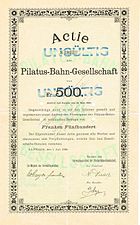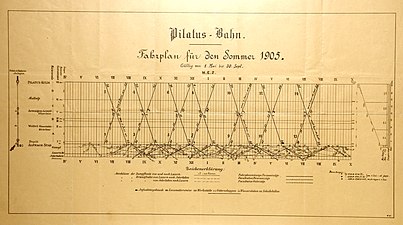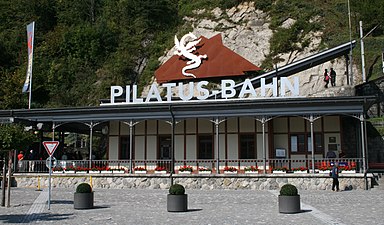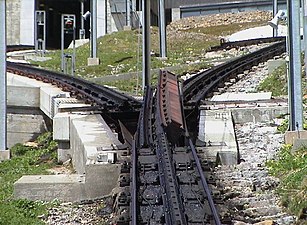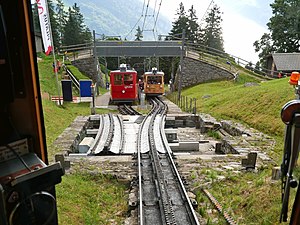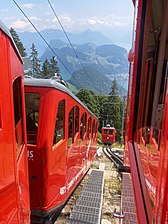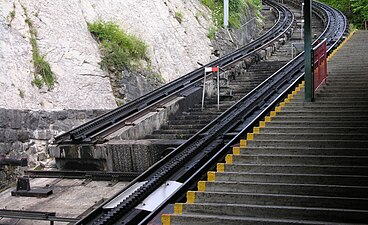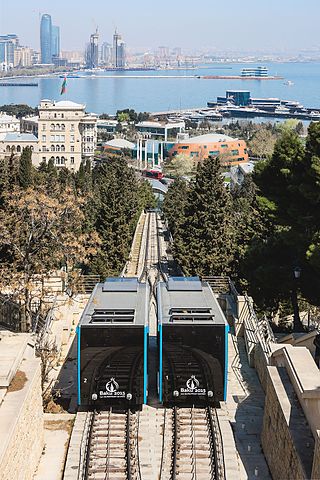
A funicular is a type of cable railway system that connects points along a railway track laid on a steep slope. The system is characterized by two counterbalanced carriages permanently attached to opposite ends of a haulage cable, which is looped over a pulley at the upper end of the track. The result of such a configuration is that the two carriages move synchronously: as one ascends, the other descends at an equal speed. This feature distinguishes funiculars from inclined elevators, which have a single car that is hauled uphill.

A rack railway is a steep grade railway with a toothed rack rail, usually between the running rails. The trains are fitted with one or more cog wheels or pinions that mesh with this rack rail. This allows the trains to operate on steep grades above 10%, which is the maximum for friction-based rail. Most rack railways are mountain railways, although a few are transit railways or tramways built to overcome a steep gradient in an urban environment.

A railroad switch (AE), turnout, or [set of] points (CE) is a mechanical installation enabling railway trains to be guided from one track to another, such as at a railway junction or where a spur or siding branches off.

The Snowdon Mountain Railway is a narrow gauge rack-and-pinion mountain railway in Gwynedd, north-west Wales. It is a tourist railway that travels for 4.7 miles (7.6 km) from Llanberis to the summit of Snowdon, the highest peak in Wales.

Pilatus, also often referred to as Mount Pilatus, is a mountain massif overlooking Lucerne in Central Switzerland. It is composed of several peaks, of which the highest (2,128.5 m [6,983 ft]) is named Tomlishorn.

The Broadmoor Manitou and Pikes Peak Cog Railway is a cog railway that climbs one of the most iconic mountains in the United States, Pikes Peak in Colorado. The base station is in Manitou Springs, near Colorado Springs.

The Brünig railway line is a Swiss narrow gauge railway line that links Lucerne, in central Switzerland, with Interlaken, in the Bernese Oberland. The line runs via Alpnachstad, Giswil, Meiringen and Brienz, and passes over the Brünig Pass, using sections of rack railway to overcome the gradients, but with most of the line operated by normal adhesion methods.

The Fell system was the first third-rail system for railways that were too steep to be worked by adhesion on the two running rails alone. It used a raised centre rail between the two running rails to provide extra traction and braking, or braking alone. Trains were propelled by wheels horizontally applied and retracted by springs onto the centre rail, controlled from the cab, as well as by the normal running wheels. In practice, the running wheels could be allowed to run freely to reduce wear, but the centre brake shoes needed to be replaced frequently. For example: the locomotives' shoes were replaced after each journey on the Mont Cenis Pass Railway. Extra brake shoes were fitted to specially designed or adapted Fell locomotives and brake vans, and for traction the prototype locomotive had an auxiliary engine powering the horizontal wheels. The Fell system was developed in the 1860s and was soon superseded by various types of rack railway for new lines, but some Fell systems remained in use into the 1960s. The Snaefell Mountain Railway still uses the Fell system for (emergency) braking, but not for traction.

The Skitube Alpine Railway is an Australian standard gauge electric rack railway in the Kosciuszko National Park in New South Wales. It provides access to the snowfields at Blue Cow Mountain and the Perisher Valley.
Hillclimbing is a problem faced by railway systems when a load must be carried up an incline. While railways have a great ability to haul very heavy loads, this advantage is only significant when the tracks are fairly level. As soon as the gradients increase, the tonnage that can be hauled is greatly diminished.
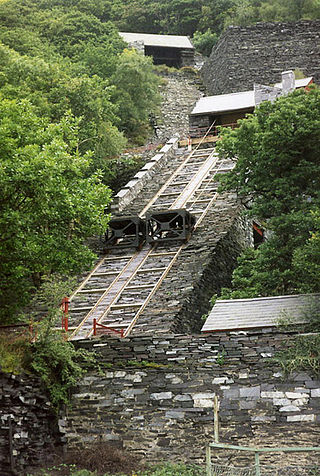
A cable railway is a railway that uses a cable, rope or chain to haul trains. It is a specific type of cable transportation.

Rigi Railways is a railway company that operates a group of railways on the mountain Rigi, located between two of the arms of Lake Lucerne, in Switzerland. They include two standard gauge rack railways, the Vitznau–Rigi Bahn (VRB) and the Arth–Rigi Bahn (ARB), along with the Luftseilbahn Weggis–Rigi Kaltbad (LWRK) cable car.

The Zentralbahn is a Swiss railway company that owns and operates two connecting railway lines in Central Switzerland and the Bernese Oberland. It was created on January 1, 2005, with the acquisition of the independently owned Luzern–Stans–Engelberg line, and the Brünig line of the Swiss Federal Railways. The company has its headquarters in Stansstad.

Eduard Locher was a Swiss engineer, inventor and independent contractor who received a doctorate honoris causa for his work. He devised the Locher rack railway system and built his privately owned Pilatus Railway that uses this system.
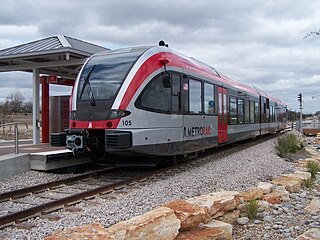
The Stadler GTW is an articulated railcar for local transport made by Stadler Rail of Switzerland. GTW stands for Gelenktriebwagen.

The Matterhorn Gotthard Bahn ABDeh 4/8, also known as Komet, is a two member class of metre gauge electric trains operated by the Matterhorn Gotthard Bahn (MGB), in the Canton of Valais, Switzerland.

The Matterhorn Gotthard Bahn ABDeh 4/10, also known as Komet, is a three member class of metre gauge electric trains operated by the Matterhorn Gotthard Bahn (MGB), in the Canton of Valais, Switzerland.

Brünig-Hasliberg railway station is a Swiss railway station located at the highest point of the Brünig Pass. It is on the Brünig line, owned by the Zentralbahn, that links Interlaken and Lucerne. The station takes its name from the name of the pass, and the resort area of Hasliberg, which lies to its east. It provides an interchange with a route of PostBus Switzerland, which operates between Brienz and Hasliberg, via the station. The station is one end of a popular hiking trail to and from the summit station of the Brienz–Rothorn railway.
A steep grade railway is a railway that ascends and descends a slope that has a steep grade. Such railways can use a number of different technologies to overcome the steepness of the grade.

800 mm gauge railways are narrow-gauge railways built to a track gauge of 800 mm.

